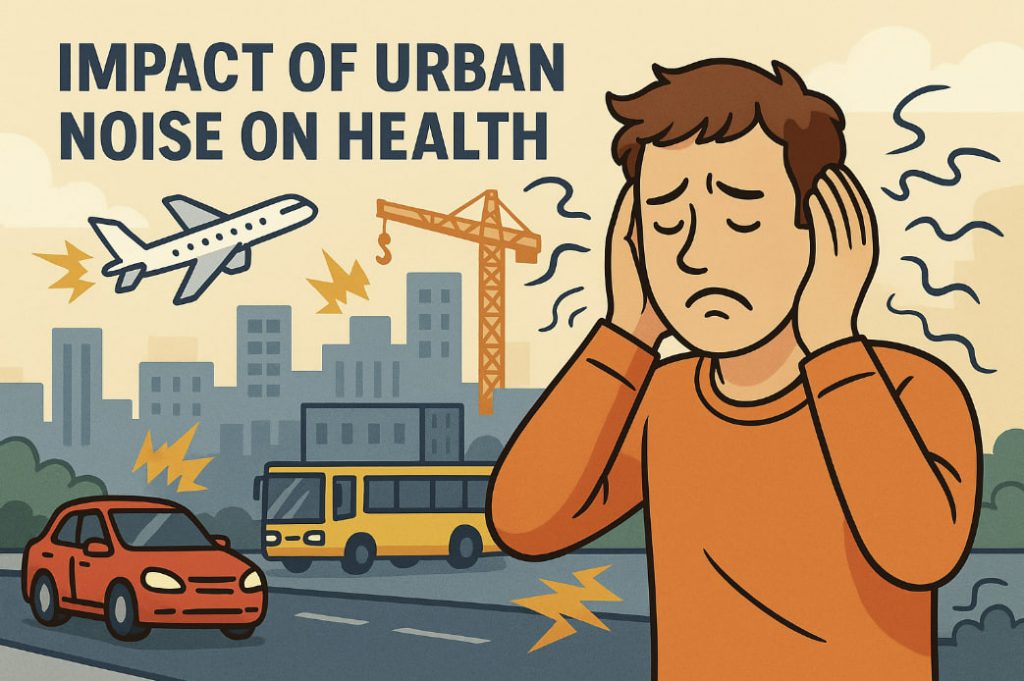In modern cities, noise is an inescapable part of daily life. From the roar of traffic and construction to the constant hum of people and machines, urban noise pollution has become a silent yet pervasive threat. Unlike other forms of pollution, noise doesn’t leave visible traces—but its effects on physical and mental health are profound and well-documented.
What Is Urban Noise Pollution?
Urban noise pollution refers to unwanted or harmful sound originating from urban activities, such as:
- Road and rail traffic
- Construction work
- Industrial operations
- Air traffic
- Crowded public spaces
The World Health Organization (WHO) considers any sound above 55 decibels (dB) during the day and 45 dB at night as potentially harmful for human health in residential areas.
How Noise Affects Health
1. Hearing Damage
Exposure to high levels of sound—especially above 85 dB—can damage the inner ear, leading to hearing loss over time. Although city noise typically doesn’t reach these peaks continuously, frequent exposure to loud sirens, construction, or loud music can contribute.
2. Sleep Disturbance
Even low-level noise at night can interfere with sleep quality, leading to:
- Difficulty falling asleep
- Frequent awakenings
- Shorter REM cycles
Poor sleep increases the risk of depression, obesity, diabetes, and cardiovascular problems.
3. Cardiovascular Disease
Chronic noise exposure activates the body’s stress response system, raising cortisol levels and blood pressure. This physiological reaction has been linked to:
- Hypertension
- Heart attacks
- Stroke
Studies show that people living near airports or busy roads have a significantly higher risk of heart disease.
4. Mental Health Impacts
Noise pollution contributes to chronic stress, irritability, cognitive fatigue, and even anxiety disorders. Children exposed to constant noise may experience slower learning, reduced attention spans, and language development delays.
5. Reduced Cognitive Function
Studies on schoolchildren have shown that classrooms located near noisy environments (such as train lines or highways) report lower reading comprehension and memory performance compared to quieter areas.
Vulnerable Groups
Certain populations are more affected by urban noise:
- Children: More sensitive to noise-related stress and learning interference
- Elderly: Often suffer from sleep disruption and worsened cardiovascular effects
- Shift workers: Need sleep during daytime when noise levels are higher
- People with existing conditions: More likely to be negatively affected by stress-related impacts
Strategies for Mitigation
Efforts to reduce the health burden of urban noise include:
- Urban planning with green buffers and noise-reducing materials
- Traffic restrictions in residential zones
- Quieter infrastructure (e.g., low-noise pavement, sound barriers)
- Building insulation and double-glazed windows
- Public education campaigns on noise awareness
- Legislation and regulation to limit nighttime noise
On a personal level, individuals can:
- Use white noise machines or earplugs during sleep
- Choose housing away from major roads or airports
- Support green initiatives that reduce traffic and noise
Glossary
- Decibel (dB) – A unit that measures the intensity of sound. A whisper is about 30 dB, while city traffic can reach 85 dB.*
- REM cycle – A phase of sleep important for memory consolidation and emotional regulation.*
- Cortisol – A hormone released during stress that affects many bodily systems, including cardiovascular health.*
- Noise pollution – Unwanted or harmful sound that interferes with normal activities or wellbeing.*
- Cognitive fatigue – Mental tiredness that reduces attention, memory, and problem-solving skills.*


